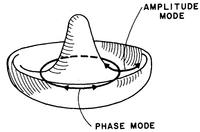
Spurred by some strange experimental observations in some superconductors, the theory of a new collective mode in superconductors and how it can be experimentally found very easily under certain circumstances was provided in 1981. It was called the "Amplitude Mode" to distinguish it from the "Phase Modes" which provide Josephson effects and which in homogeneous superconductors are coupled to charge density fluctuations and are at the energies of the plasmons. More generally, this mode is the amplitude mode of a particle-hole symmetric U(1) eld, i.e the model treated by Higgs and others in the1960's whose generalizations have played an important role in the standard model of particle physics.
I will tell the story of the above and why such modes were missed in the theory of superconductivity for so long and the applications of the ideas about such modes for cold bosons and fermions in optical lattices and in quantum anti-ferromagnets. I will also comment, as a very interested outsider and an enthusiast, on the Higgs in particle physics being discovered at LHC from the point of view of the theory of superconductivity.

